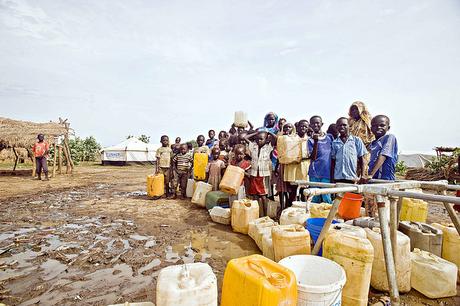What is Water Crisis?
Did you know that only 2.5% of all the water in the world is fresh water? And that only 1% is accessible, by accessible I mean trapped in glaciers and snow fields. We only have real access to 0.0007% of the planets water, that’s all we have to feed and fuel over 6.8 billion people. The lack of clean water is a plague which affects 1.8 billion people every year.
A water crisis is when there is not enough potable water for a population, which in turn leads to drought, famine and death.
Today safe drinking water has become a luxury for people living in drought hit regions and African subcontinent. People can be seen walking miles and spending entire day searching for it. Even if they get it, they have to fight with the water borne diseases arising from it. Economic development suffers when basic necessities are not met and people have to struggle hard for them. Still, we people take it for granted and do not understand the importance of water conservation. Today we will be going over some of the causes, effects and possible solutions for the water crisis.
Clean water and access to food are some of the simplest things that we can take for granted each and every day. In places like Africa, these can be some of the hardest resources to attain if you live in a rural area.
~ Marcus Samuelsson

Causes of Water Crisis
1. Water Pollution – Most of the sources of water in rural areas are terribly polluted due to poor sanitation and lack of waste treatment plants. Overall levels of global pollutants are having a negative effect on the drinking water that is currently clean, as time goes on this damage will be exacerbated.
2. Groundwater over drafting – The excessive use of groundwater in our agricultural industries is leading to diminished yields and wasted water. Over 70% of our water is used to grow crops and most is wasted due to leaky pipes and poor watering techniques.
3. Overuse and misuse of water – This leads to more water being wasted and squandered for pointless reasons and leads to further escalations of the crisis. One single hamburger takes 630 gallons of water to produce!
4. Disease – A large quantity of the available groundwater in the worst effected parts of the world is ridden with disease. Due to the lack of proper water treatment and recycling.
5. Climate change – Climate change is changing the way water evaporates and where it rains, pushing rainfall further south in both hemispheres
6. Mismanagement – Improper training and education leads to needless waste of safe clean water every day, as well as overuse in areas that don’t require so much water.
7. Corruption – Simply put. Some of the people who have the power to help those people in need just don’t care.
8. Lack of institutions – Lesser developed countries have no institutions to advise on water treatment and management, this leads to mismanagement and waste
9. Lack of infrastructure – Poor regions often don’t have the funds or education to implement proper infrastructure such as waste treatment and recycling plants
10. Loss of groundwater – Due to climate change, human expansion and development is leading to loss of groundwater worldwide.
11. Unfair pricing of water – Areas of extreme poverty often have to pay extortionate rates in order to purchase clean water. Those who have no money have to drink from holes in the dirt, or puddles on the roadside.
Effects of Water Crisis
Below are the effects of water crisis on us.
1. Death – All life needs water, every 90 seconds a child dies from water related illness and disease.
2. Disease – Waterborne disease is one of the leading causes of mortality in the world, water related disease affects more than 1.5 billion people each year.
3. Warfare – Regional conflicts have arisen due to the loss of safe water sources.
4. Lack of irrigation – Without water, farmers can’t grow any crops, which leads to the death of nearly 1 million people every year.
5. Lack of sanitation – Which leads to disease, and causes countless health issues and leads of disease.
6. Lack of hygiene – 1/3 of the world’s population lives without access to a toilet. This leads to disease and kills nearly 1 million people each year.
7. Agricultural problems – No water means no crops. Previous regions with a good amount of water have seen a decline in the ground water and without water, they cannot grow crops.
8. Livestock problems – The lack of water leads to the impossibility of keeping livestock, which in turn makes it even harder for people in arid regions to find food and income.
9. Malnutrition – Due to lack of water and the ability to grow crops, malnutrition sets in, increasing the chance of disease and death. 160 million children suffer from chronic malnutrition linked to water and sanitation.
10. Birth defects – Lack of nutrition during pregnancy and malnutrition causes birth defects in infants.
11. Poor education – Most schools in the worst affected areas do not have a toilet or safe drinking water for students, which leaves students dehydrated and mentally incapable of achieving well in schools.
12. Poor Healthcare – Most hospitals and clinics operate without access to safe water, leaving them unable to safely help people.
13. Societal impact – Improvements in society are halted due to a constant need to find water, 5-6 hours every day is spent looking for water on average. Collectively, women and children spend 125 million hours every day collecting water.
Economic effects of water crisis
1. Wasted time – Roughly $24 billion worth of time is wasted each year gathering water.
2. Loss of funds – Ending the water crisis would result in $32 billion in benefits by reducing health care costs and increased productivity.
3. Cost of death – Ending the water crisis would result in $18.5 billion dollars from deaths avoided.
Effects of water crisis on the environment
1. Increased Salinity – Due to poor treatment of water and sanitation. This leads to more water being unsafe to drink.
2. Nutrient pollution – Algal growth caused by excessive nutrients in groundwater is rendering more water being unsafe to drink to high levels of nitrate.
3. Loss of floodplains – Due to human expansion, leads to drying of riverbeds and loss of habitat.
4. Drying of riverbeds – Due to poor agricultural practices and human expansion. Leads to loss of habitat and less water access for poor regions.
5. Loss of habitat – Leading to extinction of species relying on water to survive in arid climates.
6. Subsidence – Caused by the loss of groundwater, leads to landslips and sinkholes.

Solutions to Water Crisis
1. Charities – Donating to a charity will help in a small way, charities help people in rural areas get access to waters by constructing wells, sanitation and agricultural systems.
2. Funding – Governments could allocate more funding toward ending the water crisis, currently the US government donates $8 billion every year, $1 Trillion is needed to solve the problem in the long term.
3. Spreading the message – Educate people better on the causes and effects of the water crisis, as well as what they can do to help. So they in turn can teach others and raise awareness.
4. New technologies – Incentivize innovation in the fields of water recycling, conservation and consumption.
5. Improved irrigation – Change the way we irrigate. Roughly 70% of the world’s freshwater is used to grow crops; we could improve these practices to use much less water than we currently use.
6. Water pricing – Research the true effects of water pricing. Experts are currently debating increasing the price of water to reduce pollution, but that would take water even further out of reach by those experiencing poverty
7. Energy efficient desalination plants – We need to start finding the means to make the current desalination plants more effective. By reducing the energy required to run these plants, we will help millions of people worldwide.
8. Rainwater harvesting – Areas with very little groundwater reserves can greatly improve the way they harvest rainwater by building larger facilities and incorporating better technologies.
9. Address pollution – We, as a species, need to address the ever growing challenge of pollution. Enough studies have been done now, it’s time to take action and quickly, in order to save billions of lives.
10. Population growth control – Until we solve the water crisis, it may be beneficial to limit the expansion of the population. This will lead to more accurate predictions of water needed for the next 100 years.
11. Climate change – Experts say that by decreasing the effects of global warming by pursuing cleaner energies, that will in turn help with the water crises as we find new technologies to keep water safe, and use less energy to do so.
12. Transfer of technologies – More developed countries who have a higher level of technological advancement can help out greatly by sharing their advancement with developing countries.

